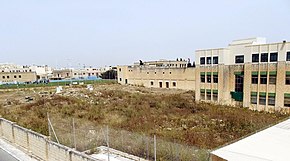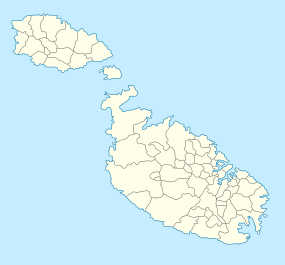Żejtun Roman villa
| Villa Rumana taż-Żejtun (Maltese) | |

The Roman villa complex in Żejtun.
|
|
| Location | Żejtun, Malta |
|---|---|
| Coordinates | 35°51′6.12″N 14°32′8.304″E / 35.8517000°N 14.53564000°E |
| Type | Settlement |
| History | |
| Periods | Late Bronze–Early Byzantine |
| Cultures | Borġ in-Nadur phase, Phoenician, Roman |
| Site notes | |
| Ownership | Public |
| Public access | Restricted |
| Partly unexcavated, within the grounds of a public school | |
The Żejtun Roman villa is an archaeological complex in the city of Żejtun, in south-eastern Malta. The open-air remains contain areas of original Roman tiling and coloured stucco. The complex was an active settlement since the Bronze Age, although the presently visible remains can be mainly dated from the Punic period right up to Late Antiquity. The site was discovered in 1961, with the complex being the subject of two large-scale archaeological investigations, the first of which was carried out in the 1970s.
More evidence of ancient habitation in the area comes from burial grounds, such as those around St Gregory's Church, Tal-Barrani, Tal-Ħotba and Bulebel. The excavation site at the villa confirms the presence of a thriving olive oil industry on the southern end of the islands.
The site is located in the grounds of the St Thomas More Secondary School in Żejtun.
The remains rest on the highest point of a long, flat ridge stretching in an east-west direction. The villa can be found close to the eastern end of the ridge. Beyond the secondary school grounds on the east side, the ridge dips significantly towards Tas-Silġ and Delimara, along the main road leading to these destinations. The ridge dips gently to the north and south, beyond the main road. The road maintains more or less the same altitude to the west until Bir id-Deheb, with the ground rising again towards Gudja and the parish church of Ħal Għaxaq. The remains, therefore, are a couple of metres higher than the old parish church of Saint Catherine's (the present St Gregory’s church) and considerably higher than the present Żejtun parish church.
Local people had known of the existence of ancient remains in the vicinity, it was not until 1964 that archaeologists systematically excavated the site, which had been accidentally uncovered by workmen when a school was being built. Various Punic and Roman tombs were discovered in the area around Żejtun, the most interesting being the burial complex at Tal-Barrani, with evidence of substantial restructuring in the 7th century. On April 8, 1963 a tomb was discovered and investigated by the local authorities “in the field immediately to the east of the new village school.” It contained both Punic and Roman material, including a “third century lamp, a glass unguentarium…and a large peg based amphora split to serve as a child’s sarcophagus”
...
Wikipedia

